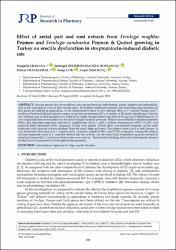Comparison of essential oils and antimicrobial activities of Ferulago mughlae Pesmen (Apiaceae) growing in Turkey

View/
Access
info:eu-repo/semantics/openAccessDate
2019Author
Karakaya, SongülDelimustafaoğlu Bostanlik, Fatmagül
Göğer, Gamze
Demirci, Betül
Kılıç, Ceyda Sibel
Metadata
Show full item recordAbstract
Ferulago species have been utilized dated from ancient times as antihelmentic, carminative, digestive, sedative, aphrodisiac, along with as salads and spice in view of their exclusive odors. F. mughlae Pe.men was investigated for its chemical compositions of essential oils and antimicrobial activity. Antimicrobial activities of essential oils were performed via TLC bioautography methods and essential oils were analysed via GC and GC/MS. alpha-pinene (53.0%), myrcene (3.9%), limonene (6.0%) beta-phellandrene (11.0%) were shown to be as primary components of fruit. Primary components of aerial part were found as alpha-pinene (48.5%), camphene (10.6%), beta-pinene (4.8%) and limonene (3.0%). alpha-pinene (37.3%), camphene (9.1%), limonene (5.3%), terpinolene (3.4%), beta-caryophyllene (3.6%), borneol (9.5%), kessan (8.0%), germacrene B (4.0%), caryophyllene oxide (3.7%) and 2,3,6-trimethylbenzaldehyde (3.7%) were shown to be the primary components of root. Aerial part and fruit essential oils of F. mughlea contain active compounds against Staphylococcus aureus ATCC 6558 while these essential oils did not show any activites against Candida albicans ATCC 90028 and Escherichia coli NRRL B-3008 strains. Root essential oil of F. mughlea did not show any antimicrobial activities against tested all microorganisms. The antimicrobial activities against these microorganisms from this species may be based upon the existence of the primary compounds in the essential oils.
Source
Journal of Research in PharmacyVolume
23Issue
1Collections
- Makale Koleksiyonu [488]
- Scopus İndeksli Yayınlar Koleksiyonu [8325]
- WoS İndeksli Yayınlar Koleksiyonu [7605]

















